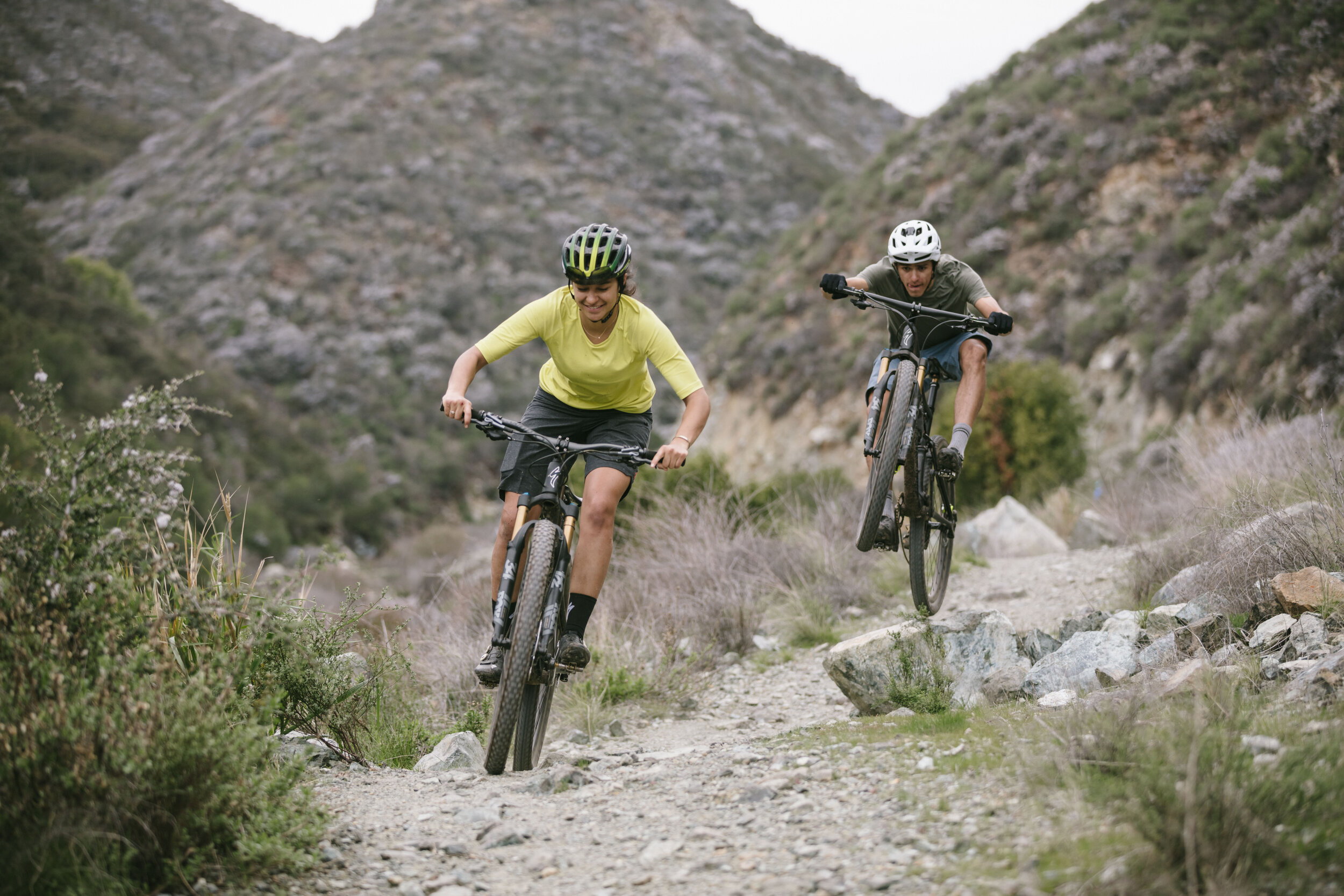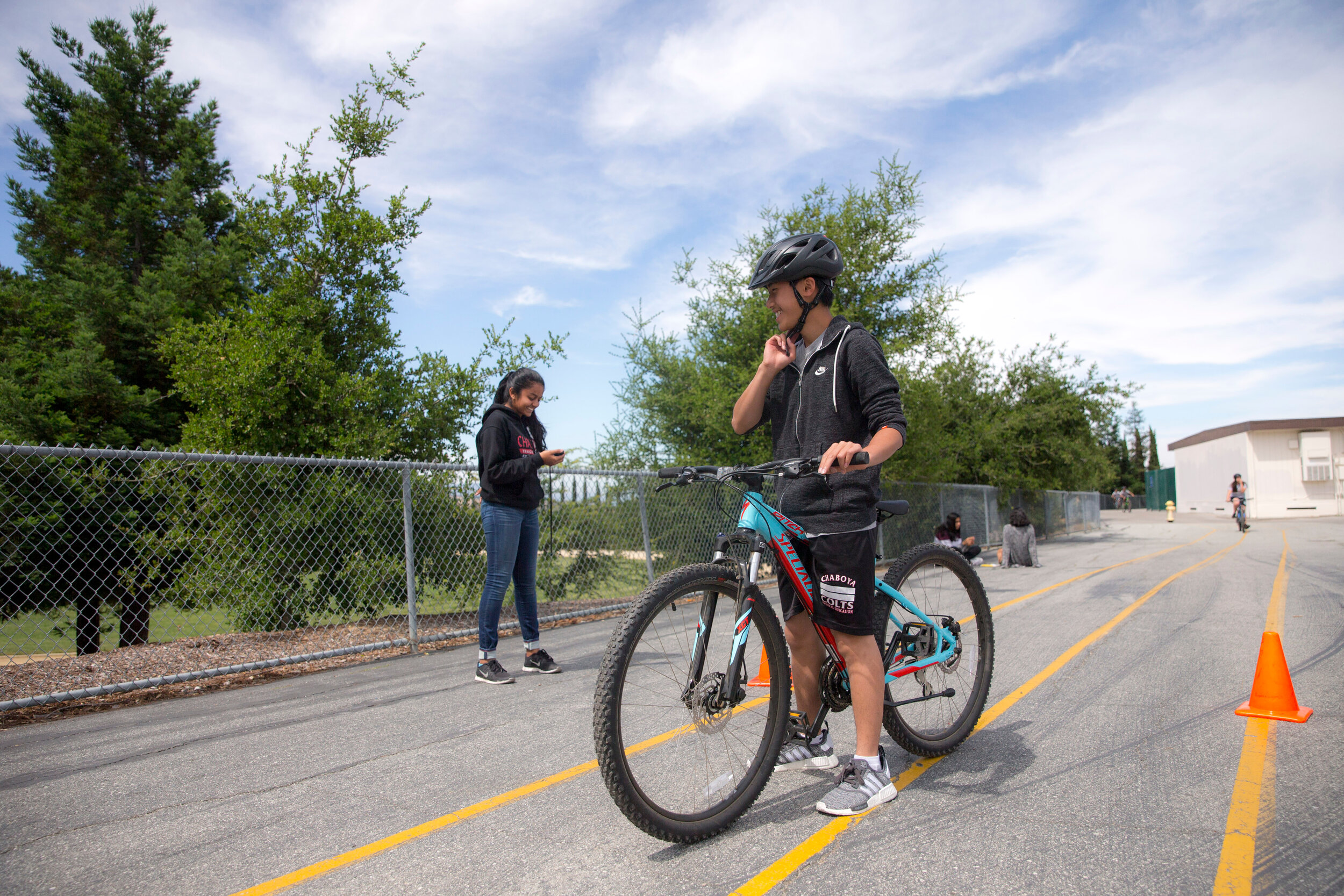
WHY CYCLE?
The unique features of cycling make it particularly valuable when promoting physical and mental fitness. Cycling requires a constant and ongoing awareness of situations and anticipation that is unique from other aerobic activities. These features contribute positively to cognitive function in young people and aging adults. Additionally, cycling accommodates varying degrees of intensity without changes in force impact on joints. Some of the potential benefits of cycling regularly include improved heart health, higher self-esteem, less stress, increased brain power, stronger immunity, burning more fat throughout the day, and prolonged life.
Outride has compiled these materials for the World Health Organization’s (WHO) Healthy at Home Campaign in response to the COVID-19 shelter in place restrictions. While we wholeheartedly support you staying active, we first want to emphasize the importance of complying with the guidelines set forth by the WHO, CDC, and state governments – we all must do our part to aid in reducing the infection rate both here in the US and globally. This means riding in smaller groups restricted to those you live or quarantine with, avoiding public spaces, and respecting travel restrictions. It’s important to think of the implication a crash could have on your family/friends and the medical resources in your area – especially during this time of our strained healthcare system. As a reminder, social distancing and washing your hands frequently and thoroughly are currently the best ways to prevent the spread of COVID-19.
What do I need to go out for a bike ride?
While the only critical items are your bike and helmet, the other items might come in handy.
1. Bike (preferably with shifters and gears)
2. Helmet (new within 4 years)
3. Tools to adjust bike parts and inflate tires. Some common ones: bike pump with air pressure gauge, screwdrivers (one medium flat-head and Phillips), allen wrench set (ranging from 2-12mm in size), simple open-ended wrench / spanner set (or a ~12” crescent), needle-nose pliers with wire cutters
4. 10-20 cones or markers (anything that can get run over)
5. Sidewalk chalk or safe alternative
BEFORE YOU RIDE
Before each and every ride, a rider needs to perform three pre-ride skills to ensure the ride and rider will be safe and free from mechanical issues. The skills are: Bicycle Inspection, Helmet Fit, and Bicycle Fit. While you may already know these skills, we recommend completing these activities as a refresher.
Bicycle inspection
A proper bike check is similar to what a driver would do before they operate a vehicle. The same applies in bicycling. Riders must make sure the bicycle is safe and functional BEFORE they set out on a ride; you don’t want something to break or fail during the ride. Performing a bike check properly identifies any issues and allows them to be addressed before it is too late. Here are the critical elements of a Bicycle Inspection:
Check both tires for appropriate air pressure and for damage to tires. You can often find the recommended tire pressure printed on the side of the tire rubber.
Check both front and rear brakes for function, alignment, and rubbing by spinning each tire and squeezing each brake independently.
Check the shifting mechanisms for abnormal grinding, noises, or rubbing. Note: Do not attempt to shift gears while the bike is stationary/not moving. This can lead to gear damage and difficulty starting.
Check the front chainring (gears) by grabbing the pedals and jiggling them, feeling for looseness.
Check the chain visually for rust and function by turning the pedals forward with the rear wheel off the ground or reverse, safely.
Check all quick releases and other fasteners on bike (seat post, front, and rear wheel, handlebars, stem) for proper tension (tight enough to stay closed and for parts to not move, but not too tight where rider is unable to open);
Visually inspect any other equipment attached to the bike. Check that all is not loose or can become loose and interfere with riding.
helmet fitting
A properly fitted helmet is the second step in ensuring a safe ride. Riders should take the time to fit the helmet according to manufacturer's specifications as each helmet has unique features. Here are the critical elements of a properly fitted helmet:
Helmet is snug on head; no excessive movement (more than ½ inches) when rider shakes and nods head.
Helmet sits level on head; base of helmet is within 1-2in from top of brow
Straps form a V, under ears, within ½ in from lobe of ear
Strap is no more than ½ inch below chin, snug without constricting when mouth is opened.
bicycle fitting
The final step to ensuring a safe, comfortable, efficient ride is the bicycle fit. Every bicycle is different, but requires adjustment so the rider can create force safely and control the bike effectively. Here are the keys to setting up for bike fit:
Adjust the saddle/seat height so that the knee has a slight bend when the foot/pedal is at the 6 o’clock position.
Keep the saddle/seat below the maximum height. Every seat post has a mark that limits the extended height for safety. If the rider needs a seat higher than the mark on the seatpost, the rider may need a larger bicycle.
Saddle/seat is near level.
Take note to not feel sensations related to improper fit— Knees stretched or constricted; arms outstretched or cramped; toes don’t reach ground when seated level on saddle. These may indicate that the bicycle is too large or too small.
READY TO RIDE
Once riders are “up to speed” on how to ride safely and prevent mechanical issues, they should practice some critical cycling skills before they venture off on their own. The following is a list of essential cycling skills for improving safety, confidence, and competence on the bicycle. We recommend riders complete all the activities in the list in order they are presented to ensure they don’t progress too quickly, and to help them learn the skills more effectively. Feel free to skip around if the rider has previous experience.
essential cycling skills
Starting/Stopping - Starting and stopping a bike are the first steps in handling a bicycle safely. To be considered safe and competent while starting, riders need to be able to start a bike while looking up and maintaining control of the bike. To be considered safe and competent while stopping, riders need to be able to shift weight back, use both front and rear brakes (if applicable) soft enough to not leave a skid mark, but hard enough to stop quickly, while keeping eyes up and coming to a complete stop and putting one foot down.
Balance/Control - Having Balance and control is the next critical skill in developing confidence and competence to be considered safe and competent while stopping. To be safe while riding riders should be able to ride a straight line 5m long, under 15kph, with little to no corrective movements.
Cadence/Shifting Gears - Cadence in cycling refers to the number of pedal revolutions per minute, or RPM. Cadence is important in cycling because it can reduce injury and stress on knees, conserve energy, and let muscles recover between pedal strokes. The ideal cadence for most riders is between 80 and 90 rpm. For bicycles with gears, shifting gears is the only way to maintain the proper cadence as terrain and speeds change. To be considered safe and competent, riders must shift gears at least 5m before speeds or elevations change (up and down), in order to maintain a cadence of 80-90 rpm.
Turn/Weave - The skills that combine balance and coordination and allow riders to safely change direction are the Weave and Turn. Riders need to practice turning and weaving different distances, directions, and speeds. To be considered safe and competent while weaving, riders must travel through 5 cones spaced 2-3m apart at least 15km/h, in a smooth manner, with eyes up, clearing every cone. To be considered safe and competent while turning, riders must navigate a 90 degree turn in both directions, in a smooth manner, by leaning their body and bike appropriately.
Scan/Signal - Once riders can Stop, Start, Maintain Balance, Weave, and Turn, they now need to be able to do all of those things while managing their surroundings. For scanning, riders need to constantly look around and develop an awareness of people, cars, and objects around them. For signaling, they need to communicate their intended direction of travel to everyone around them. To be considered safe and competent while scanning, riders must be able to look in all directions while maintaining control and balance on the bicycle. For signalling, riders must signal their direction of intent (check local ordinances), early and often, up to 30m away from the turn. They must continue to hold signal until the point of turn (or going straight) and make eye contact with humans in the area before proceeding.
APPLYING THOSE RIDING SKILLS
Riders who are competent and confident can apply their skills in various on-road and off-road settings. Each style of riding has unique skills, so make sure to learn those before you decide to dive in. Remember to research local laws and ordinances regarding the use of bicycles on motorized and non-motorized trails and pathways, too. Consider riding on trails, dirt paths, your neighborhood, or downtown for some ice cream once shelter-in-place restrictions are lifted. Below are some other ideas on what to do with confident and competent riders.
Plan a bicycle scavenger hunt. Riders take photos of items they find on neighborhood rides.
Other riders or people
Items in front yards (fences, lawn ornaments, bird houses, unique vehicles, fire hydrants)
Items in backyards (play houses, pools, sheds)
Signs (Caution, Stop, Slow)
Unique or interesting plants, trees, natural objects
Houses and buildings or businesses
Riding over different surfaces, like uneven and narrow paths, up and down hills.
Riding over boards, curbs, and other linear objects.
Set up a rodeo (challenge course) in a parking lot or around the house. Design stations using objects you have on hand.
Keep track of and map rides using Strava or Garmin Connect.
Additional Resources
Get cycling inspiration realness from Outride’s Athlete Ambassadors on our Instagram page
Healthy at Home Resources
World Health Organization (WHO) Country and Technical Guidance
My Hero is You, storybook for children on COVID-19
Cycling Resources
Specialized Bike Like a Boss, Issue #1, The Basics of Biking
Specialized Bike Like a Boss, Issue #2, Cycling Etiquette
















